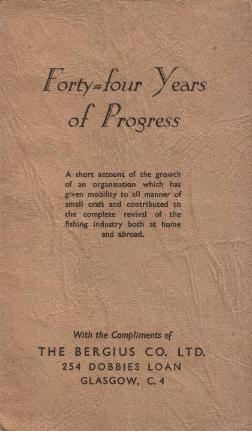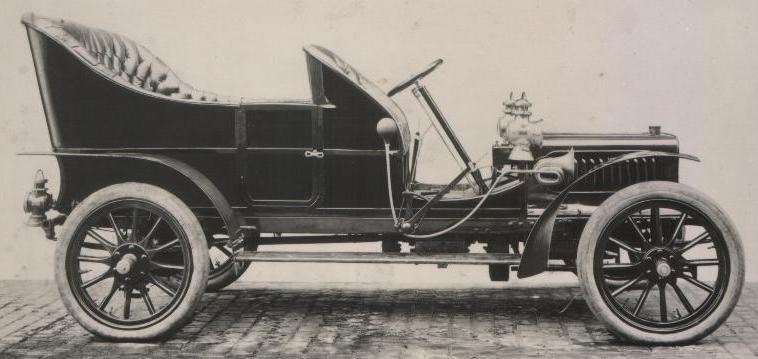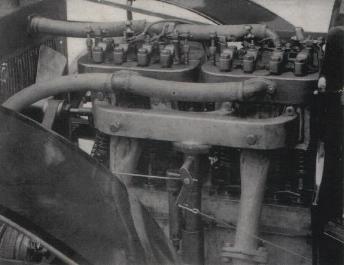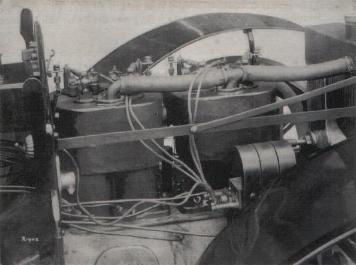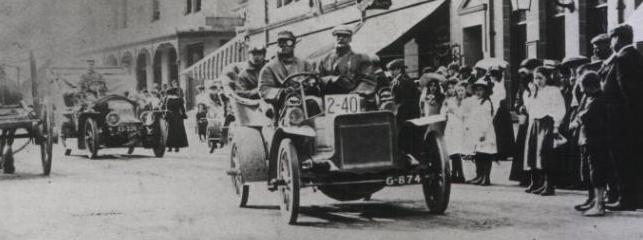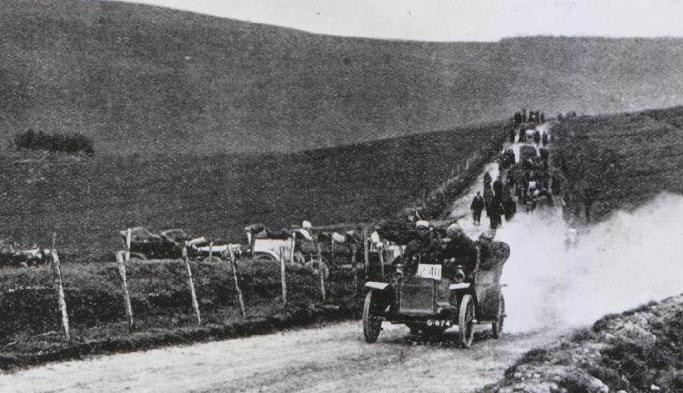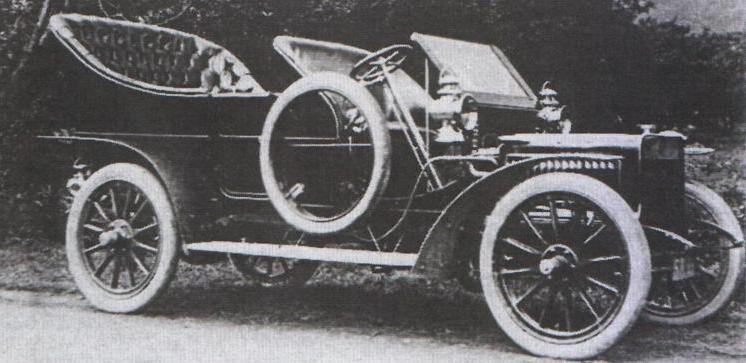This book was published in 1948 a
year before the death of Walter M Bergius
In the beginning . . .On 30th May 1904, The Bergius Car and Engine Co. announced its intention to make motor cars and entered premises at 169 Finnieston Street, Glasgow. These consisted of a first floor and attic, rent £75. The "Company" consisted of Walter Bergius (23), David Willocks (20), G. Rutherford, J. Muir, and W. Hunt. The total weekly wage bill was £4 17s. 6d. The "Shop" worked 54 hours per week. The "Staff' came in at nine o'clock and left in time to catch the last train home! Mr Bergius, who drew no salary for four years, did the design and worked in the shop. Mr Willocks was the commercial head, but was usually to be found working at the bench. George Rutherford made all the patterns and the bodywork with great skill, while W. Hunt was machinist, assisted by all hands. The total plant was insured for £500, the principal item being a centre lathe which cost, new, only £66. The plant was driven by a 9hp gas engine of uncertain age.
The first "Kelvin" car was ready in seven months, notwithstanding that the engine and transmission, the axles, wheel hubs, radiator, and bodywork were all made on the premises. In those days, motor car manufacture was not a matter of assembling parts produced by specialists.
The first car had solid tyres, a body with rear entrance, a 3-speed gear box with constant-mesh gears, dog clutches, and a "live" axle driven by cardan shaft - most cars were chain driven in those days. The ignition was by a low tension system with make and break within the cylinder, devised by the late Doctor Murray, the designer of Arrol-Johnston and Albion cars. This system could stand water and for that reason was more reliable than the alternative then available - battery and trembler coil - but it restricted the speed of the engine to about 9OOrpm, at which speed it developed only l4hp as compared with 50hp in the case of a modern engine of the same size. The power was measured in the time-honoured way by a rope round the flywheel and a spring balance - satisfactory until the rope took fire!
The pioneer car crashed its cylinders on its trial trip, but the cylinders were redesigned, patterns altered, cast, machined, and in service within three weeks. Those were the days before restrictions on "overtime".
Subsequent cars had a side entrance body and pneumatic tyres. A London gentle man bought one and set out for home with a light heart! Another got through the Scottish Reliability Trials consisting of 1,000 miles over the worst hills in Scotland.
Kelvin car c1906. This picture is from a catalogue prepared in Spanish
When twelve cars had been sold, the Company's resources were almost exhausted. Mr William Bergius - a brother of our managing director - then suggested that the engine might be modified to suit motor-boats. He promptly acquired a four-oared rowing gig, 23ft long, installed an engine, took part in all the motor-boat races and scooped the pool! This established the "Kelvin" as a marine engine.
The engine was then applied to fishing craft and, when most of the British fishing fleet had been engined, larger models were designed and the process began again. In the early days a fishing boat engine was 7hp, driving a folding side propeller, and without either clutch or reverse gear - a very simple installation. The cost, installed complete, was only £70, of which the fisherman usually borrowed half from his friends and the other half from the engine-maker. These little engines increased the fishing capacity of the boats to such an extent that the balance of the price was usually paid off before it was due. Some of the engines made before 1910 are still in use.
The Bergius folding propeller was the idea of Mr William Bergius, and was satisfactory in those days when power was only auxiliary to sail.
The engine in a modern fishing boat costs £800 to £1,500. The fishing industry has increased in like proportion and a good deal of the expansion is directly due to the advent of the "Kelvin" engine.
"Kelvin" engines are now produced in a modern factory containing 350 machine tools and covering five acres. This development is typical of the private enterprise which built British Industry. Wordsworth said "The Child is Father of the Man".
Number 169 Finnieston Street also has some claim to mention, because it was occupied by J. & G. Thomson, now John Brown & Co., Ltd., of Clydebank, and later by The Albion Motor Car Co. Ltd.
In the early years according to Walter Bergius "Willocks keeps the books when his hands are clean". After the death of the founder D. W. Willocks became Chairman.
The Bergius Company Ltd. 11th June 1954
On 11th June the company celebrated its Golden Jubilee and here follows some extracts from Mr. Willocks speech on that occasion.
Ladies and Gentlemen:
You are all aware of the purpose of our gathering here today. This is the Golden Jubilee Year of our Company and, as you already know, we have decided to mark the occasion by making a payment of one week's salary to all persons in our employment at the end of May of this year. We have also decided to institute the practice of giving some award for long service, and the first of these awards is being made today. I may say that it is our intention to review the position about this time each year so that those who have just failed to qualify this time will have a chance next year. We have no fewer than 72 names with over 25 years' service, including 18 with more than 40 years' service - not a bad record for such a small firm, and one that reflects credit on employer and employee alike.As many of you know, I have been in the service of the Company since its inception, but little did I think, 50 years ago, that today I would be the only one of the original group still connected with it, if, in fact, I am not the only one still alive. For me, therefore, this Jubilee has a special significance. I would like to take this opportunity of publicly thanking those members of the Staff who so kindly presented me with a memento of the occasion in the shape of a beautiful solid silver cigarette box with silver ash tray and a table lighter, thank you all very much.
Before proceeding with the main business today, I would like you to turn your thoughts for a little to the man who, from very small beginnings, built up this very successful business - the late Mr. Walter Bergius. Some of you knew him well; to others he was just "the boss"; the younger of you did not knew him at all. I think it will give you all a better appreciation of the man, and of what he achieved, if I give you my own impressions of him over the years and my recollections of the very early days of our Company. I hope you will bear with the length of my story for I have a large field to cover.
Before 1904 I was employed under Mr. Bergius' brother Willie. I was a bit dissatisfied and wanted to get into engineering. Mr. Willie suggested that I should go to see his brother, who was talking of making motor cars. That was early in 1904. At that time Mr. Walter had the use of an office at 77 Queen Street which had been occupied by his father who had by then given up business. He confirmed that he intended to set up a motor car factory as soon as he could get premises, and would want someone who could do whatever office work was required. He could not offer to pay much and said the whole thing was a gamble. If it came off, all right; if it did not, I would be out of a job.
By the middle of May the best that offered in the way of premises was at 169 Finnieston Street, and we got possession on 29th May, 1904. The name of the Company then was The Bergius Car & Engine Company. The premises were at the end of a long yard, flanked by Clan Line and City Line repair shops. They were the first floor and attic of a two-storey building which originally was part of the large engineering establishment of J. & G. Thomson. They had been occupied immediately before us by the Glasgow Motor Lorry Co., and before that by the Albion Motor Car Co.
A more unsuitable place to make motor cars you could hardly imagine. Entrance was by an outside wooden stair and goods were taken up in an outside hoist, also of wood, something like a pit cage, suspended from a projecting beam over a sliding door in the wall. The whole place was about the size of our present pattern shop Perhaps it was much smaller, but they say "distance lends enchantment to the view!" It had no equipment of any kind other than an old gas engine at one end, driving a short line shaft. There was a wooden enclosure forming the Office space and a stair up to the attic. There was no heating, the lighting was by gas, there were no benches, no tools, no nothing.
The first week was spent in taking delivery of various items of small plant which, Mr. Bergius had ordered in advance, vices and hand tools etc, and in fitting down certain articles of furniture from the office in Queen Street, among them a typewriter of ancient vintage - a "Hammond" which was not of much use to me because I could not operate it. I think Willie Knight, who came to us in 1908, will remember it. He was our first real typist. When the typewriter was worn out we gave it to Mr. Thomas A. Smith, our agent in Gibraltar. He fixed it up and used it for years after. I think he must have been like Mr. Kipling's Mr. Hinchcliffe who could coax a stolen bicycle to do typewriting.
At the beginning there were only three of us; Mr. Bergius, a young man Jack Muir who stayed only about 6 months, and myself. The first week we engaged a pattern maker, George Rutherford, and a machinist, W. Hunt. They started on the 6th June, 1904, the same day that we got wood to make benches etc. Everything had to be manhandled, I suppose we must have got the gas engine going before the really heavy stuff arrived.
This Kelvin Car of about 1906 is one of the last of only fourteen built and was owned by A. C. Denny of Dumbarton. A 16 horsepower example, it carries the distinctive high-backed body favoured by its makers and has the refinement of a windscreen. It is registered SN 99, a Dunbartonshire issue.
Tradesmen worked 54 hours per week then. The standard rate was 8d per hour or 36/- per week, and our total weekly wage bill was a little over £4.10/-, so some of us did not live very fat. Mr. Bergius, of course, got nothing. I myself worked in the Shop except on pay days. As Mr. Bergius once said "Willocks keeps the books when his hands are clean".
To cut a long story short, we had the first car completed and taken down in the hoist for a road trial by Xmas of the same year. When I say "We" I mean Mr. Bergius; the other 4 of us only did what we were told.
The first car had a wooden body with back entrance, something like a buggy, and had wooden wheels with solid rubber tyres. Unfortunately, its first run was short. It had only travelled a few yards when part of the ignition make and break mechanism broke off and the piston punched the broken part through the cylinder head - so the car was taken up in the hoist again. The cylinder was redesigned to practically the present 3 1/2" pattern, and the ignition gear altered to the flexible rod type which was standard on our engines until we adopted high tension ignition about 1911. The car was on the road again early in 1905; only three weeks to redesign and remake the ignition gear, alter the cylinder pattern, get new castings from Cruikshank, machine them and fit them. Changed days!
In the Spring of 1905 we made 3 cars with pneumatic tyres. The first car with solid tyres had a habit of getting into the tramway rails and following them round corners where one did not want to go. The new cars were well upholstered and painted by a coach builder. They were of the accepted 4-door type, open, of course; very few saloon then; not even a windscreen. The driver and passengers wore goggles, and they needed them, for the dust was awful; no tarred roads.The first of these 3 cars was sold to a friend of Mr. Willie's - a Mr. McKean of London - who took delivery himself in July 1905 and drove it home to London without mishap. I remember going to Bethwall Circus with it to have it photographed on the forenoon of the day it left. You can see the picture on the wall. The second car was sold to Mr. Bergius' father, and the third to a Mr.Hunter of Kilbarchan, in November. By that time we had another batch of 12 on the go and one was exhibited at the Motor Show in Edinburgh early in 1906 whore we again exhibited in the following year.
In March 1906 Mr. William Bergius ordered an engine to be installed in a 23-foot rowing gig which had been removed from a large sailing yacht. The hull cost us only £7; at least, that is what we charged Mr. Willie. I do not remember if we added anything for profit, but we had profit on everything else, even down to 5/- for the use of a drill. The engine was installed at Kirn where James Litster did the woodwork. The result was the launch "KELVIN", which won practically every race it was entered for in its class and continued to do so until our Mr. Bergius designed "KELVIN II", also a 23-footer with only about 4'3" beam, and which, in 1908, was accounted the "crack" boat on the Clyde with nine Firsts and one Second to its credit. She was sold eventually to a man, R.I. Dobbie, who was such a reckless character that people christened the boat "DOBBIE'S COFFIN"; they were so sure he would be drowned in it. He was not, however.
These successes set the seal on the "KELVIN" as a marine engine and as the sale of cars was rather sticky they were given up, and a good job too, as we were about bankrupt by that time. You must not think that Mr. Bergius was always a wealthy man He had very little money when he started this business and if his father had not come to the rescue we would have been sunk by 1907.
In the summer of 1906 we sold a 4-cylinder engine to J. & G. Forbes of Sandhaven and two 4-cylinder engines to John Munro of Oban, and I think our friend Bob Wotherspoon, who came to us in March 1906, installed the latter and ran the trials. That summer also - 1906 - we entered a car in the Scottish Reliability Trials, The crew consisted of Mr. Bergius, Bob Wotherspoon and Sandy Watson, and an observer from the Automobile Club. The trials consisted of 4 days driving over about 800 miles of not very good roads, including some of the worst hill climbs in Scotland. The "KELVIN" did very well except on the Devil's Elbow hill climb where it had to shed a passenger. The road surface was very bad because of the large cars which had gone on ahead, and of the cars in the "KELVIN" class only one got up non-stop; a "Humber", Apart from that, the "KELVIN" gave a very fine performance and no mechanical trouble.While all this was going on the pattern maker was not too busy and Mr. Bergius set him to building a launch which he had designed. It was 23ft. x 5ft. of Mahogany. Mr. Cree, I think, will remember it, for he came to us about that time. By the time it was planked up we had sold it for shipment to Sydney in December 1906, We could not complete it in time for the steamer and it was sent down to John Leitch at Renfrew to be finished. We had to cut a hole in the pattern shop floor to get it out, It was of very light construction and was packed in a complete case for shipment.
The first "KELVIN" engine exported, apart from that in the launch, was shipped to New Zealand in January 1907. In March of the same year we shipped one to Bombay to be installed in a launch for which we had supplied the design and timber to make the frames, In this year also we exhibited a motor car and a complete motor launch at the Olympia Motor Show in London.
The first fishing boat we engined was "THE BROTHERS" of Cambeltown, in December 1907. Prior to that date we had sold 15 motor cars, 9 launches to Mr. Burgius' design, and 67 marine engines: 22 of the engines were exported to the following places: Australia, New Zealand, Bombay, Russia, Norway, Uruguay, Trinidad, Cochin, Hongkong, Bangkok, and Fiji. Not bad for 3 1/2 years work, starting from scratch.
In 1908 we had 15 men in the Shop; 10 fitters and 5 machinists; and our sales for that year were only a little short of £10,000. In 1909 they were over £21,000 and since then we have never looked back.I do not remember how many engines we had turned out by the time we came to Dobbie's Loan early in 1910; possibly 600 or 700. Still less do I remember how we packed them. We had no Alex. Begg in those days! So much for the old shop, what about the men.
When I first knew Mr. Bergius he was a young man of 23; only 3 years older than myself. I do not know when he first had the idea to make motor cars, but he was a born engineer and had no desire to be anything else, although I think he would have been a success at anything, provided he was interested in it. He left school at 16 and served his apprenticeship with G. & J. Weir, Cathcart, and, in fact, was in charge of Weir's Stand at the great Paris Exhibition in 1900. After that he was in the pattern shop of David Rowan & Co., in the drawing office of Cockburns the valve makers - and for a short time with the Albion Motor Car Co.
Apart from his natural ability and competence as an engineer, I think the quality which struck me most was his great industry and his power of concentrating on the job in hand. He worked hard and expected his people to work hard. He was in no sense a slave driver, however. So long as a man was trying, he would put up with him, but he had no time for idlers or these who would not do certain things because "it was not their job" so to speak.
He was a very practical person and had little regard for theories or traditions, In the beginning he had little time for paper work. The Office was a necessary evil all that mattered was the Shop. As time went on he modified his ideas and came to realize that each had its place.
He very early recognized the need for standards, not only in matters of design and shop practice, but in every aspect of business. He was intolerant of what he considered to be meaningless and slipshod methods of describing articles and material and used to rail at me because we never seemed to get the same size of envelope twice running. I may say it is not so easy even today. Nowadays we have the British Standards Institution who publish standards for nearly everything, from bolts and nuts to telegraph poles and babies' rompers; then the British Institution was in its infancy and it was almost impossible to buy such simple things as spanners with any certainty that they would fit the nuts. Mr. Bergius changed all that for us. If there was not a standard he created one and insisted that every part in regular use, down to split pins, should be exactly specified on the order or on the drawing accompanying the order. There is no doubt such methods contributed largely to the smooth running of our business, whatever headaches they may have given our suppliers. One supplier told me that he had no idea what accuracy meant until he started dealing with the Bergius Co.Mr. Bergius was very methodical in all he did and laid down certain rules with regard to the practical execution of his orders in the Shop and Office, and also in regard to the firm's dealings with customers. He hated obscure or indefinite communications which used many words to say very little, and insisted on clear and direct language in letters so that supplier or customer was not laid in any doubt as to our intentions - a precept which I am constantly endeavouring to instil in those who are to come after me.
He was an individualist and did not follow fashion in engine design any more than in anything else. He had his own ideas about most things and the will and ability to carry them out. Many of them were unorthodox when they were introduced but have come to be accepted and even copied. At the same time he recognized his own limitations and the limitations of his product and would never undertake any task he did not feel able to perform well or take an order for an engine that he did not think quite suitable for the work it was expected to do. He did not like to sell an engine to be installed in some inaccessible hole where the poor thing would get neither ventilation nor attention and very often refused such orders, Neither did he cater for the customer who wanted an engine fitted with all sorts of gadgets more liable to go wrong than the engine itself. As Mr. Cree has said, "The virtue of the "KELVIN" engine is not so much in what it has, as in what it has not". I suppose the ideal engine would be composed of only one part.
Mr. Bergius never allowed sentiment to interfere with business and treated friends and even relatives on the same terms as his other customers. His business methods, brusque though they sometimes were, gave people confidence in him rather than the reverse, and they respected him for his plain speaking, knowing that he would faithfully carry out any obligation he entered into. If he had a soft spot at all it was for the working fisherman who in those early days was usually a poor man,
He was a good employer and always treated his employees fairly; in fact, he was so anxious to be fair that he sometimes ended up by being a little unfair, or so it seemed.I suppose we are all more or less honest according to our lights, but Mr. Bergius, to my mind, was honest, not only in his dealings with other people but with himself, If he wanted anything made or done for his home or for his yacht he was charged up for it. No running a car at the firms expense for him. You may say, what did it matter, he got most of the profit anyway. It was for that exact reason that I think it did matter.
He was dignified and modest in manner, and even spartan in habit. When others in his position might have used a Rolls-Royce he was content to come to business in a tramcar or a Ford 10. It was only a few years before he died that he would consent to have rubber covering on the cement floor in his room. You see, he never had much time to sit around, but spent most of his time at his drawing board where he was an exceptionally fast worker. Just as his engines were not cluttered up with a lot of useless gadgets, so his drawings omitted all embellishment or fancy printing and cryptic signs. Not only did he design his own engines but he was a competent Naval Architect and designed many standard launches and numerous extras such as steering gear, boat fittings, etc. He designed his own motor yachts down to the last halyard and block.
You must not think from what I have said about his spartan habits that he was in any sense a mean man. No man was more generous, as many of us have occasion to know. It was just that he did not like ostentation or display. He was not really interested in money for money's sake but only in his work. He took few holidays in the real sense and was not interested in games or in any sport except where boats were concerned. He loved sailing, but even that was only a change of occupation for him, because he did most of the work himself, even the cooking and washing up.
I have tried in those very inadequate words to give you some picture of the man as I knew him. I have touched on, if I might use alliteration, his industry, his individuality, his inventiveness, and his integrity.To such a man, sometimes exasperating but always loveable, are we indebted for the opportunity to meet here today.
He died on 4th June, 1949, five years ago, and only those of us who knew him best realize how much we lost.
This business is his monument and we - you, I, all of us here - are the custodians of that monument and of the good name and reputation he built up.
Postscript from Mr. George Bergius (son of Mr. Walter M Bergius).
My Father died in 1949 and the business ceased to be a family concern (death duties). The Bergius Car & Engine Co. built 15 KELVIN cars in the 1904 - 1906 period. Have any survived?
